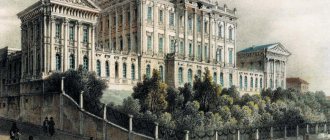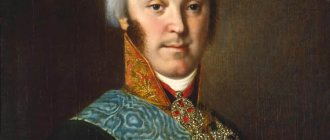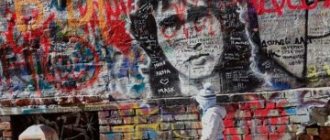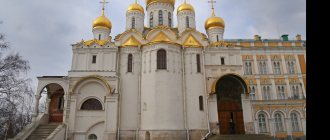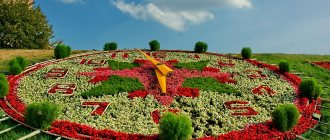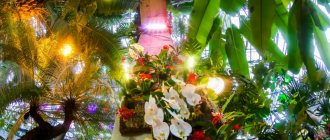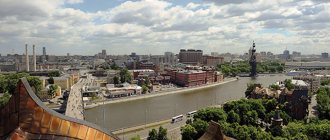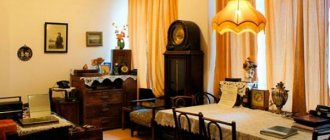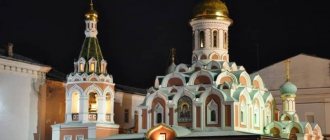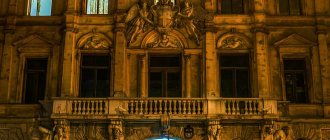Round miracle
In a residential building on the street. Nezhinskaya, no. 13, there is not a single square room: all have the shape of a trapezoid, because the length of the house along the outer ring is greater than along the inner one. The ring house, built in the early 1970s according to the design of architect Stamo and engineer Markelov , still gives the impression of an architectural miracle today. It’s no wonder that his twin house on Dovzhenko, next to Mosfilm, was chosen by directors. Vladimir Menshov the final shots of the film “Moscow Doesn’t Believe in Tears” there.
The project was experimental: 6 arches, 9 floors, 26 entrances, almost 1000 apartments in each of the ring houses. On the ground floor there is a store, a studio, a pharmacy... The Stamo architectural bureau designed the entire residential area of Matveevskoye, in particular Veernaya Street, so named based on the construction principle.
The famous round house at the address: st. Nezhinskaya, 13. Photo: stroi.mos.ru
History of construction
The project of the original structure was developed by the People's Architect of the USSR Evgeniy Nikolaevich Stamo and an engineer by training Alexander Markelov.
In the 70s of the last century, panel residential buildings of the same shape were mainly erected, and the question arose - how to build cheaply and beautifully at minimal cost.
Then the idea came to place standard panels at an angle of 6 degrees, which corresponds to the maximum permissible deviation when joining panels according to SNiP.
The first round residential building was erected in 1972, and the second in 1979. To complete the loop of such a structure, it was necessary to build a huge building, inside of which there was a space the size of a football field.
Living in such a dwelling was quite comfortable - on the ground floor there were all the necessary services and facilities, including shops and a pharmacy, a laundry and atelier, a post office and a shoe workshop, and in the round courtyard the children chatted cheerfully and noisily and children's voices only died down for a while school activities.
It should be noted that in the 70s there were not many cars in Soviet families and no one had any problems driving in or parking.
Inspired by the result, the architects even wanted to build up the entire capital with such houses; one of the proposals was the construction of one round building inside another.
On the eve of the 1980 Olympic Games, the idea was put forward to build five such ring houses in the Olympic Village, but, after reflection, the architects came to the conclusion that such a composition could only be seen and appreciated from a bird’s eye view, and on the ground an ordinary pedestrian would not understand the idea designers.
Another thing is the lonely round house - it looks interesting and unusual, although it is an ordinary nine-story panel building of the I-515/9 series, built using ordinary building materials.
At the same time, with the onset of the 90s after the fall of the planned economy, many shops and household services closed and maintaining such housing became much more difficult. It has become difficult to park in the yard, and if you don’t know the entrance number, it’s difficult to find an apartment.
In addition, the layout of apartments in these buildings is reminiscent of Khrushchev’s, and during renovations, residents experience inconvenience due to the curvature of the walls.
By now, shops and services have returned and are working properly, and most residents are satisfied with their housing - after all, they live in a legendary house known to everyone, which is affectionately called a kolobok.
Who's in favor
The former settlements of Aminevo, Volynskoye, Matveevskoye, Ochakovo, Troekurovo... In 1960, they entered the boundaries of Moscow, so that almost 40 years later they would form Ochakovo-Matveevskoye. But what about the villages, known since the 14th century! A resident of the area, local historian Olga Vologina believes that this area is much more ancient. For three years she collected material to write the book “Ochakovo-Matveevskoe. 5000 years of history."
“Our area is one of the few in Moscow where such large-scale research was carried out on Slavic antiquities that in the 1930s, marks of the found mounds appeared on the map of the Moscow region,” the author reveals the intrigue. “And recently, during the construction of a residential complex, the settlement of Ochakovo-1 was discovered.”
With the establishment of princely power in Muscovy, the village of Volynskoye, and with it the assigned Aminevo, Ochakovo and Matveevskoye, changed owners many times. Convenient location (several hours' journey to the Kremlin), rivers rich in fish and fertile water meadows turned Volynskoe into a bargaining chip, by which one could find out who was now in favor at the Moscow court.
Question answer
How to “read” the coat of arms of the Ochakovo-Matveevskoye district?
The story of Afanasy Lobanov-Rostovsky is indicative . A friend of Tsar Mikhail Romanov's youth, his favorite, he received positions one after another. And then the village of Volynskoye with its adjacent estates. This royal gift was the last straw of patience for Patriarch Filaret, who feared the influence of his favorite on his son the Tsar. Afanasy was first sent to Nizhny Novgorod, and then to Sviyazhsk for the voivodeship - in fact, into exile. On the way to his duty station, he died. The village of Volynskoye went to the treasury.
By the way
In the area there are 29 streets, 2 railway stations - Ochakovo and Matveevskaya. And only 1 metro station – “Ozernaya”.
round house
In ancient times, such buildings were built from various materials and served different purposes. The round house was common both in Europe and on other continents, including southern Africa. According to archaeological data, these could be military buildings, religious buildings and residential buildings. This type of dwelling is characteristic of the ancient Celtic culture in Europe and is found in England, Spain and the Mediterranean. The construction of round houses was carried out from wood and stone, on solid or pile foundations, which shows the high plasticity and adaptability of the concept. Some buildings of this type have survived to this day and are of historical and cultural value. The development of modern architecture has revived the interest of architects in this original form of housing.
Sturgeons from Setun
From time immemorial, the nearby village of Matveevskoye belonged to the metropolitans of Rostov - delicious sturgeon were sent to them from the deep Setun River.
The scion of the ancient boyar family of the Troekurovs, who owned a neighboring village, not only gave the name to the village, but also became the founder of the temple, created in the style of the Great Embassy, which is rare for Russia. Today, the Church of St. Nicholas the Wonderworker (Ryabinovaya St., 24A) is the only one in Moscow built in this style (in Holland it is called northern baroque) in 1745. It has remained unchanged.
The architectural design of the Church of St. Nicholas the Wonderworker is the only one of its kind in Moscow. Photo: Commons.wikimedia.org/ A.Savin
In 1781, the rector of Moscow University, Mikhail Kheraskov, became the owner of the village of Ochakovo. A poet and playwright, a supporter of the ideas of the Enlightenment, he also founded the Noble Boarding School (Zhukovsky, Lermontov and Tyutchev were educated there) and was knighted in the Rosicrucian Order.
After the restoration of villages and villages burned by Napoleon's soldiers, throughout the 19th century they lived an ordinary peasant life, which changed radically only with the advent of the Kyiv railway. Brick factories are being built, a workers' settlement is growing on one side of the road, and dachas are growing on the other, in one of which Archpriest Valentin Amphiteatrov lives. Half of Moscow comes to him for advice...
Article on the topic
The story of one street. Natasha Kovshova Street, Ochakovo-Matveevskoye District
Why the project of residential buildings of unusual shape was canceled
After the construction of two Moscow “donuts” and several years of their operation, it became clear that such houses were no good. They were extremely expensive to maintain and repair. In addition, it took much more money to build one round house than to build a regular one. This was due to the design features; monolithic walls had to be erected in several places. In the area on which one round house was located, it was possible to build several standard high-rise buildings, and therefore increase the number of apartments.
Thus, the high cost of construction, the bulkiness of buildings and the inconvenience of maintenance completely stopped the appearance of other round houses in Moscow.
Our heroes
The fate of people associated with the Ochakovo-Matveevskoye region is no less interesting than the historical and architectural monuments. For example, three streets are named after women - heroes of the Great Patriotic War: Maria Polivanova, Elena Kolesova, Natasha Kovshova . Each has its own life story. Just like the famous traveler Przhevalsky, after whom one of the streets is also named. A lot of interesting things happened in the area in the 1970s. Akira Kurosawa filmed scenes for the film Dersu Uzala here. Four years on the street. Matveevskaya, 6, lived Vladimir Vysotsky. A ring house was built and the House of Cinema Veterans was opened (Nezhinskaya St., 5, building 1). One of the guests turned out to be Anatoly Kubatsky, who played the role of Vodokrut XIII, who left his son an apartment in Moscow and moved here to live out his life among the same old people.
The Troekurovskoe cemetery has long been a memorial and historical object. Just look at the “Alley of Actors”, where you can talk about everyone for hours: Valentina Tolkunova, Natalya Gundareva, Lyubov Polishchuk, Vyacheslav Nevinny, Semyon Farada, Igor Kvasha, Vladislav Galkin...
Sundial with zodiac signs in Anna German Square. Photo: AiF/ Yuri Trubnikov
Ochakovsky Park, the natural reserve “Valley of the Setun River” with the Matveevsky Forest, the park named after Anna German , where the Russian biographer of the singer and resident of the area Ivan Ilyichev holds evenings and competitions . And also the Museum of Traditional Russian Drinks, where you can taste kvass. And all this is the Ochakovo-Matveevskoye district, which is developing to become even more attractive.
Photos of the ring house
Several photos of the Ustinov Ring House on the Fontanka.
The sky in the courtyard of the house is a ring. This is how they look up here and make wishes...
The courtyard of the round house is paved with paving slabs. Not a very comfortable courtyard, full of ringing silence, I must say. But his appearance is really some kind of mystical...
Blank windows on the inner wall on the courtyard side...
Bottom to top - photo from under the entrance arch of the apartment building-ring
Ring house - photo from the yard, from the garden side
Window facing the courtyard. An interesting artifact - it is clearly clear that the house is residential, and also residential...
A shot of the outer wall with the woodshed's gate. An interesting element of architecture. You know, walking around the Internet you can come across statements that this is a carriage house, I even came across such a crazy expression as “carriage garage”. No, this is a typical woodshed - that is, a room for storing firewood. If there was space in the yard, it was built in the form of a separate woodshed. And if there was not enough space, they built it into the house. Mentions of such architectural artifacts of pre-revolutionary St. Petersburg can be found in the book “From the Life of Old Petersburg” by D.A. Zasosov and V.I. Pyzina. And as for the carriage house... hmm... - well, think for yourself what kind of carriages and carriages there are in houses where people lived with an income of the level of Raskolnikov or an old money-lender... Fragments of statues in the courtyard of the house. The photo is old - 2013. They have now been removed. I don’t know where this sculpture was originally located, maybe on the roof, or maybe somewhere else...
Sculpture of a woman with a child in the courtyard of a round house...
Fragments of a reclining statue in the courtyard of the ring house. Judging by the reinforced concrete fittings, these are creations of the Soviet period, but, judging by their pose, they were not on the roof, but in the nearby garden behind the wall...
The exit from the courtyard of the house is ring. Let's look at the sky, make a wish and your dream will definitely come true. The tour of the witching city is completed for today, and you still have a walk through the amazing places of unusual St. Petersburg.
Enjoy your walk through informal St. Petersburg. Your Ulrich von Beck
Tags: mysticism, house, building, St. Petersburg, History of St. Petersburg, architecture, ring, circle, Petrov, street, Mystical Petersburg, Fontanka, Gorokhovaya street, courtyard, St. Petersburg, merchant, Ustinov, Zagorodny Prospekt, Sennaya Square
- Back
- Forward
